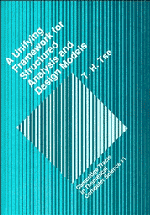 A Unifying Framework for Structured Analysis and Design Models
A Unifying Framework for Structured Analysis and Design Models Book contents
- Frontmatter
- Contents
- Preface
- List of Tables and Figures
- Chapter 1 Introduction
- Chapter 2 Desirable Features of Systems Development Environments
- Chapter 3 A Comparison with Related Work
- Chapter 4 An Initial Algebra Framework for Unifying the Structured Models
- Chapter 5 A Functorial Framework for Unifying the Structured Models
- Chapter 6 The Identification of Unstructuredness
- Chapter 7 A Prototype System to Implement the Unifying Framework
- Chapter 8 Conclusion
- Bibliography
- Index
Chapter 5 - A Functorial Framework for Unifying the Structured Models
Published online by Cambridge University Press: 28 January 2010
- Frontmatter
- Contents
- Preface
- List of Tables and Figures
- Chapter 1 Introduction
- Chapter 2 Desirable Features of Systems Development Environments
- Chapter 3 A Comparison with Related Work
- Chapter 4 An Initial Algebra Framework for Unifying the Structured Models
- Chapter 5 A Functorial Framework for Unifying the Structured Models
- Chapter 6 The Identification of Unstructuredness
- Chapter 7 A Prototype System to Implement the Unifying Framework
- Chapter 8 Conclusion
- Bibliography
- Index
Summary
INTRODUCTION
An initial algebra framework has been proposed in the last chapter to integrate the structured systems development models. Given a specification in one structured model, the framework provides a formal means of mapping it to an equivalent specification in terms of another model. It does not, however, provide a means of developing the specification in the first place. Not does it consider refinement.
We find that the proposed term algebra as well as the DeMarco, Yourdon and Jackson notations fit nicely into a functorial framework. We can integrate the models by providing functorial bridges from one type of specification to another. An overview of the functorial relationships is shown in Figure 5.1. The framework also provides a theoretical basis for manipulating incomplete or unstructured specifications through refinement morphisms.
The main advantages of the functorial framework can be summarized as follows:
(a) A systems developer may conceive the target system in terms of structured tasks, which are the equivalents of standard structuring mechanisms such as sequence, selection and iteration used in the structured methodologies. The DeMarco, Yourdon or Jackson notations are simply seen as variations on the same theme.
(b) Although the initial algebra framework provides a formal means of mapping a structured specification from one form to another, it does not offer much help at the initial stage when we are trying to develop the specification. Using the functorial framework, we can refine a draft specification of structured tasks using morphisms, which preserves structuredness. Properties of continuous functions and structured functions can be used to verify the correctness of such manipulation. These concepts help a systems developer to visualize the internal structure of a system, assemble or refine subsystems, and verify the consistency and completeness of a design.
[…]
Information
- Type
- Chapter
- Information
- A Unifying Framework for Structured Analysis and Design ModelsAn Approach Using Initial Algebra Semantics and Category Theory, pp. 70 - 93Publisher: Cambridge University PressPrint publication year: 1991